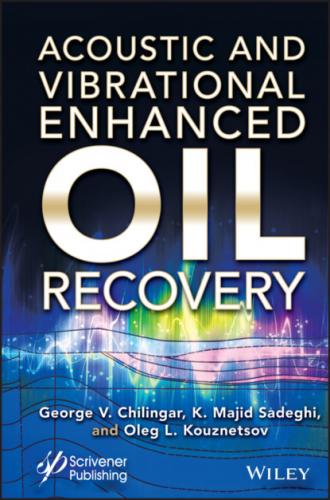The first term in this equation corresponds to a wave converging to the cylinder axis, and the second term corresponds to the wave expanding from the cylinder. For the expanding running waves, the kr number must be a real value, i.e., the condition
Energy interrelations at wave irradiation from wells by an axisymmetric source have been studied in [10]. Connections have been identified between field energy parameters and well’s acoustic impedance. Also studied has been the nature of frequency and amplitude distribution on the irradiation surface onto the energy transmission into the massif. At the fixed spatial frequency ξ of a source u0 harmonic amplitude offset distribution, equations have been derived for per-unit impedance of the well-loading massif. Radial resonance frequencies of a ring liquid layer between the emitter body and the casing and antiresonance frequencies also have been determined. The energy release into massif at the resonance frequency turned out to be most efficient.
Based on a solution of the dispersion equation for Rayleigh waves in the reservoir, a case has been reviewed when the irradiation was totally disappeared. The well acoustic impedance in this case becomes equal to zero and the well becomes absolutely “soft”. The total energy flow through the well’s walls at that becomes equal to zero, although in a near-surface layer quite significant densities are created of the kinetic and potential energy. At θ ˃ θR, the acoustic energy may enter the reservoir from the well only in a case of normal fading of waves in the liquid. This moment corresponds with a case of an infinitely long cylinder surface-wave mode of which is excited by a low-frequency action within the well
Wave excitement form well considering reservoir elastoporosity was studied by Rakhmanov et al. (1985) [19]. The boundary conditions at the surface of a liquid-filled cylindrical well were assigned in the form of a tension in the solid phase and pressure in the liquid generated by moving at a constant speed load charge as follows:
Restricted solutions of the Bio equations satisfying the irradiation conditions allows one to derive equations for calculating offsets and tensions in the solid phase as well as the pressure in a fluid-porous medium.
White [23] reviewed the absorption mechanism of normal waver spreading in the well fluid caused by fluid pulsation flow through the permeable walls of an uncased well. His results were appropriate for low frequency, when the tube-wave length is large compared with the well diameter. If to evaluate the contribution of such fading by a normal wave in its radiation at subcritical frequencies, then with the frequency decline, approximately from 100 Hz and to very low frequencies, the fraction of vibration energy irradiated into the massif monotonously grows to some value determined by the media permeability. Regardless of permeability, at frequency above 100 Hz, this phenomenon make practically no contribution to the irradiation of vibration energy. These results apply to uncased wells and did not take into account the mechanism of wave energy reradiation through a well fluid.
In order to increase the efficiency of energy introduction into the reservoir at low frequency, it is necessary to find a possibility to increase substantially the irradiation from a well into the reservoir by changing loading parameters and optimally utilize action of resonance properties of the well and reservoir systems. The existence of resonance regimes of vibration present in a well, which are associated with parameters of the enclosing medium and emerging in a pre-critical frequency area, is experimentally confirmed. For instance, if to run in a fluid-filled well a receiver of sound vibrations and to measure the energy spectrum of the noise, then in a fluid-saturated reservoir the resonance frequency may be identified.
The resonance excitation in a well may be achieved at the regime of high-frequency radial resonance of the fluid layer as well as a lengthwise resonance of the fluid column at low frequency. The radial resonance is determined by the well radius and emerges at high frequency on the order of dozen kilohertz and higher. Thus, coordination of the operation regime of the vibration source and the reservoir achieved, so that practically the entire power of the vibration source is transferred in the reservoir. By varying the frequency and load distribution on the surface of the vibration source, it is possible to control field energy structure in the reservoir. However, practical utilization of the radial resonance is substantially complicated for the following reasons. The frequency even of the first radial resonances at the existing well radiuses are too high both for favorable manifestation of elastic vibration action mechanisms on the reservoir and for the frequency coordination with the reservoir excitation resonance regimes. Besides, high-frequency elastic waves experience a strong fading in the reservoir. As the motions of porous medium at such resonances are radial, the generation of high-pressure amplitudes in wells is restricted by the acceptable radial displacement of the casing and cement column.
At lengthwise resonance, the vibration frequency of the fluid column in a well is defined mostly by the distance between reflecting surfaces in the well. As the lower reflecting surface is usually taken the dib hole and as the upper, the fluid and gas contact next to wellhead. At long distances between these boundaries, the vibration resonance frequency may reach the value on the order of 1 Hz and lower. Nevertheless, efficient utilization of lengthwise resonances at low frequencies is associated with certain difficulties. For creating the resonance lengthwise vibration of the entire fluid column in a well, it is necessary to know the fluid level in the well and the phase velocity of a tube wave propagation in it. It is practically impossible to support a constant fluid level in well in most technological operations. On taking the reflection properties from the lower boundary (the dib hole), they are clearly low because the wave resistance in the cement and in the surrounding reservoir
